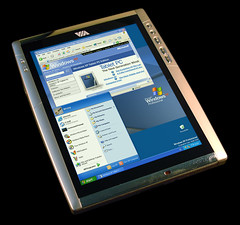CrunchPads, media pads, and mini tablets: What's really going on with these devices?
The biggest proponent of tablet PCs has always been Bill Gates. I remember talking to him about the technology at the turn of the century during one of my visits to Microsoft; he said someday the tablet PC would be the norm for mobile computing. I assume he's still high on the use of a stylus or touch as part of a computer's interface, hoping the concept will catch on with consumers.
While tablet PCs in the "slate" format have found their way into vertical markets (medical and hospital programs, as well as transportation and police and fire departments), they have not caught on with the mainstream. And even the laptops known as convertibles (because their swivel screens can be used in tablet mode) haven't taken off. But a new generation of tablets could finally give this concept some legs.
The most visible at the moment comes from TechCrunch's Michael Arrington, who has been working on something called the CrunchPad. He and his team have created a prototype 12-inch tablet that uses an Intel Atom processor and a Linux OS, designed for mobile Web browsing. Tablets like these have been used for a while in vertical markets, but they're normally priced at about $2,000—and up. The CrunchPad is supposed to cost about $200, however, and if that's true, it could have serious consumer appeal. This product is in its early stages, and there is no time frame for its release (other than talk of "a user event in July in Silicon Valley"), but Arrington's work has sparked new interest in tablets, especially because of his price goals.
At a practical level, a 12-inch tablet is nice, but the larger the screen, the more it adds to weight and causes issues with battery life. I've used a 12-inch tablet around my house for the last five years, and I actually like the utilitarian nature of the product. I have it on my lap when watching TV or lying in bed at night to check the news. I even have SlingPlayer Mobile on it so I can watch my TV shows in the back yard. In concept it's a cool idea, but the high prices have really limited its consumer appeal.
Smaller tablet devices have taken aim at consumers, too, as among them the original Samsung Q1. This product was the result of a major push by Intel to create a new category of devices called ultramobile PCs (UMPCs), later dubbed mobile Internet devices (MIDs). Most of these devices had screens in the 5-to-7-inch range and sported Windows XP, making them really handheld pen or tablet computers. However, their prices weren't consumer-friendly three years ago, and even now few have caught on.
But the goal of these devices was admirable. Intel hoped to create a smaller and cheaper tablet PC, something Internet-friendly that could give users access to the thousands of PC applications already on the market. But even with these features consumers have stayed away from these devices, because in many ways they are what we call tweeners. They weren't PCs in the traditional sense, and though small, they weren't as portable as today's smartphones. To complicate matters, Apple introduced the iPhone, which in many ways embodies the spirit if not the original vision of Bill Gates's Tablet PC.
But the CrunchPad has many people looking at tablets again in earnest. For one thing, the price of the CrunchPad would put it within consumer reach. For another, it seems there is interest again in some type of mobile device that has a larger screen than a smartphone but is still portable and touch-enabled.
I recently flew from New York City to California in coach. The guy in front of me reclined so far that the back of his seat was almost in my face. This meant I couldn't work on my laptop, let alone watch a movie on it, so I pulled out my iPod touch instead. This was an okay experience, but I had to hold the screen a foot or so in front of my nose to watch a movie. I really wanted a larger iPod at that moment—or anything, really, with a screen larger than 3.5 inches. One of the more interesting options is the Archos 7 Internet Media Tablet, a great media player that also can access the Internet. In fact, this particular product, which sports a 7-inch touch screen, is the first in a new breed of consumer-friendly tablets.
A rumored device from Apple could also help make the tablet concept more acceptable to the market. It's been dubbed a media pad and is likened to an iPod touch with an 8- or 9-inch screen. (In my own twisted way of thinking, I call it an iPad, but since it's all rumor anyway, I suppose you can call it anything you want.) I don't know if Apple is actually working on anything like this, but the concept sure appeals to me. It would probably appeal to a lot of people, in fact, especially if it included the entire Apple universe of software, services, and apps that already exist on the iPhone or iPod touch.
We're about ten years into Gates's vision of the Tablet PC, and it still seems like a pipe dream when it comes to market acceptance. However, with the Archos 7 already in the market, and the potential that the CrunchPad and Apple could have in the future, perhaps tablets will finally gain attention. Perhaps they'll even fulfill Gates's vision: Touch interface and tablet PCs may eventually be the norm in mobile computing.
Technology Update: Daily Updates on newly launched Gadgets, Gizmos, Mobiles, PC's & Laptops, Hacking, Gaming & Emerging Technological Trends.












![Reblog this post [with Zemanta]](http://img.zemanta.com/reblog_e.png?x-id=008d5e99-ca29-4912-be8d-162961d9523a)











